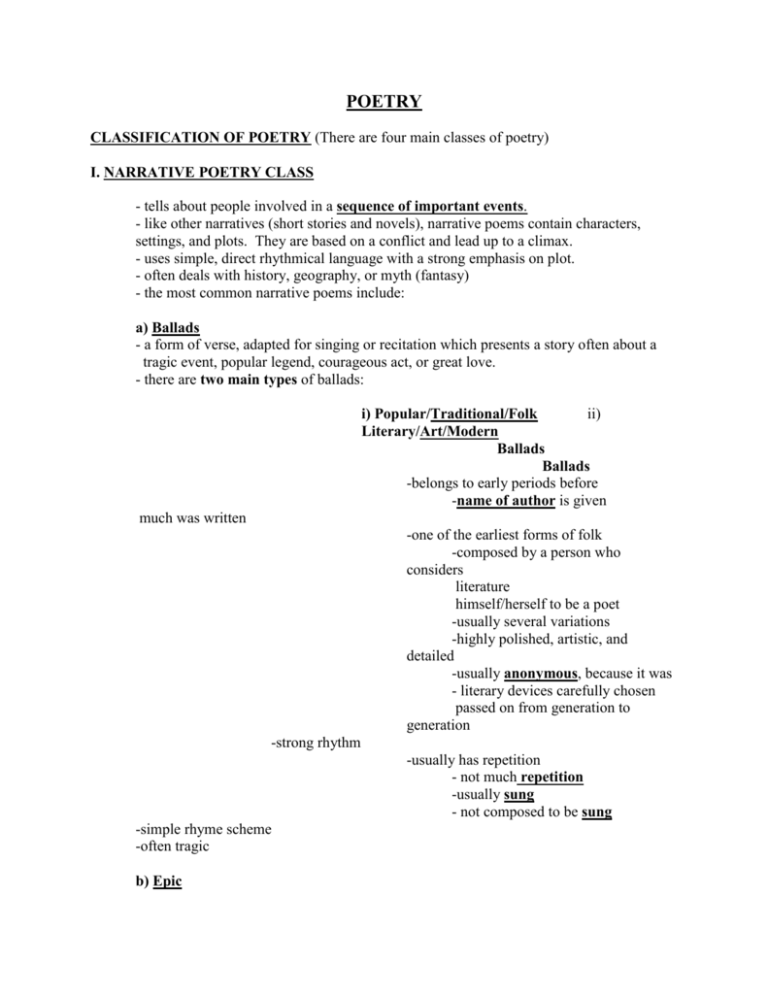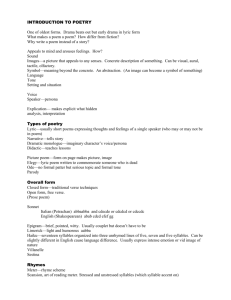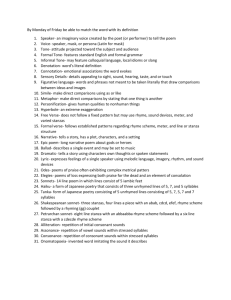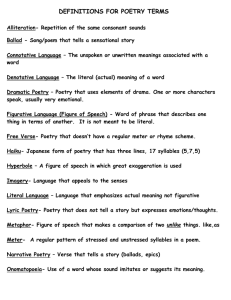Poetry Classification & Terms Study Guide
advertisement

POETRY CLASSIFICATION OF POETRY (There are four main classes of poetry) I. NARRATIVE POETRY CLASS - tells about people involved in a sequence of important events. - like other narratives (short stories and novels), narrative poems contain characters, settings, and plots. They are based on a conflict and lead up to a climax. - uses simple, direct rhythmical language with a strong emphasis on plot. - often deals with history, geography, or myth (fantasy) - the most common narrative poems include: a) Ballads - a form of verse, adapted for singing or recitation which presents a story often about a tragic event, popular legend, courageous act, or great love. - there are two main types of ballads: i) Popular/Traditional/Folk ii) Literary/Art/Modern Ballads Ballads -belongs to early periods before -name of author is given much was written -one of the earliest forms of folk -composed by a person who considers literature himself/herself to be a poet -usually several variations -highly polished, artistic, and detailed -usually anonymous, because it was - literary devices carefully chosen passed on from generation to generation -strong rhythm -usually has repetition - not much repetition -usually sung - not composed to be sung -simple rhyme scheme -often tragic b) Epic - long, serious, narrative poem recounting the deeds of heroic figures from legends or history. - written in an elevated or sophisticated style. - supernatural forces often intervene in the hero’s plans. II. LYRICAL POETRY CLASS - most popular class - poet expresses his desires, feelings, emotions, or ideals. - may be a joyful emotion (joys of friendship, love, or reflecting on nature’s beauty) or a painful emotion (loneliness, rejection, etc.). - main types: a) Short Lyrical Poetry - includes formula poetry (haiku, tanka, cinquain, diamante, and the limerick) - the epigram (brief, witty statement expressed in two to four lines) - the epitaph (a two to four line poetic inscription on a tombstone) - nonsensical or humorous poetry b) Longer Lyrical Poetry (3-8 stanzas usually) - includes the following: - the elegy (a dignified poem expressing the poet’s sorrow or praise for the dead) - the ode (entire poem is often addressed to some person, creature, or object; it has a serious subject and a dignified style) - the sonnet - it has three characteristics: - 14 lines - written in iambic pentametre - has a complicated rhyme scheme - main types of sonnets: i) Shakespearean/English Sonnet - rhyme scheme: ABAB CDCD EFEF GG - 3 quatrains (ABAB CDCD EFEF) and a rhyming couplet (GG) ii) Petrarchan/Italian Sonnet - rhyme scheme: ABBA ABBA CDECDE (in some variation) - one octave of ABBA ABBA and a sestet of CDECDE (in some variation (CCDDEE or CDCDEE for example) III. DRAMATIC POETRY CLASS - intended to be read aloud or performed in front of an audience. - usually revealed through monologue (one person speaking to the audience) or dialogue e.g. soliloquies in Shakespeare’s play, Hamlet - main types: tragic, comedic, or dramatic monologues IV. SOCIAL COMMENTARY CLASS - comments on society’s social habits, customs, attitudes, and problems in order to promote much needed changes in the individual or in society. - e.g. satires of war, political structures, the treatment of immigrants, etc. Poetry Terms and Definitions 1. Prose - spoken or written words which do not follow a specific metrical pattern - written words appear in sentence or paragraph form (essays, short stories, letters, novels, etc.) 2. Verse - poem - typically written in a metrical pattern 3. Simile - a comparison of two unlike things using as or like. 4. Metaphor - a comparison of two unlike things without the use of as or like. 5. Extended Metaphor - a metaphor is repeatedly used throughout the poem to develop the poem’s theme - many details are used to enhance the comparison e.g. school - prison teachers - wardens students - prisoners classrooms - cells 6. Onomatopoeia - the use of a word whose sound imitates, suggests, and reinforces its meaning. 7. Personification - a figure of speech attributing human qualities to animals, inanimate objects, or abstract ideas (giving something non-human human characteristics) 8. Hyperbole - an extreme exaggeration used for effect. 9. Alliteration words. - the repetition of the same consonant or vowel sound at the start of 10. Assonance - the repetition of similar vowel sounds in a line of poetry. 11. Consonance - the repetition of similar consonant sounds in a line of poetry. 12. Oxymoron - words or a phrase that combine contradicting or opposite ideas. - Greek - “oxy” - sharp; “moros” - dull 13. Paradox - an apparently contradicting statement with one element of truth in it. 14. Imagery - figurative language using the five senses to create metaphors, similes, 15. Symbolism - something representing something else especially a material object representing an abstract idea. 16. Repetition - repeating words, phrases, lines, or stanzas for four possible reasons: a) rhyme c) emphasis b) rhythm d) continuity 17. Incremental Repetition - at least part of key lines are repeated from stanza to stanza to further develop the storyline (narrative) or meaning 18. Refrain - lines of poetry that are repeated at regular intervals within the poem - a chorus 19. Allusion - an indirect reference to a well-known person, place, thing, or event from history, literature, mythology, or the Bible. 20. Apostrophe - a direct address to a person, place, thing, or idea in a line of poetry (deceased as though alive, absent as though present, or inanimate object as though animate). e.g. “O world, embrace my fears.” 21. Pun - a play on words which has three possible forms: - a word with two different meanings - similarity of meaning in two words that are homonyms - two words pronounced and spelled similarly but have different meanings 22. Antithesis - a contrast or opposition in the meanings of phrases or clauses emphasized by a parallel in their grammatical structure. - e.g. “With mirth in funeral, and with dirge in marriage.” (Hamlet) - e.g. “Marriage has many pains, but celibacy has no pleasures” (Rasselas) 23. Ambiguity - uncertainty produced by words or phrases that have two or more possible meanings. - allows for more than one interpretation. 24. Archaism - the use of words and expressions in literature that have become obsolete in common speech. - e.g. in sooth, methinks, forswear, forsooth 25. Denotation - the literal or dictionary meaning of a word. 26. Connotation - the implied meaning of a word based on emotional associations with it. - e.g. home - privacy, cozy - e.g. red - death, anger 27. Cacophony - the use of harsh, discordant sounds for poetic effect. - term is applied usually to the entire poem. 28. Euphony - the use of smooth, pleasant sounds for poetic effect. - term is applied usually to the entire poem. 29. Aesthetic - artistic; sensitive to beauty - literature, drama, music, and ballet are aesthetic arts. 30. Blank Verse - unrhymed iambic pentameter. 31. Free Verse - poem with no rhyme or rhythmic pattern. 32. Metre - a system for determining the rhythmic pattern of a poem according to its stressed and unstressed syllables. - a foot is a recurrent metric unit of stressed and unstressed syllables in a line of poetry. The four standard feet include: a) Iambic (an unstressed syllable followed by a stressed syllable) b) Anapestic (two unstressed syllables followed by a stressed syllable) -- used in a c) Trochaic (a stressed syllable followed by a unstressed syllable) d) Dactylic (a stressed syllable followed by two unstressed syllables) e) Spondaic (two stressed syllables) f) Pyrrhic (two unstressed syllables) - a metric line is named according to the number of feet in the line: a) monometre f) hexametre b) dimetre g) heptametre c) trimetre h) octometre d) tetrametre e) pentametre (five feet) 33. Iambic pentametre - five feet (each iambic foot contains two syllables; 10 syllables) of an unstressed syllable followed by a stressed syllable 34. Scansion 35. Litotes - the process of analyzing a poem to determine its metre and line length. - an understatement in which an affirmative is conveyed by stating a negative. - e.g. “Elvis is not a bad singer” - meaning he is wonderful 36. Meiosis - a deliberate understatement used for the sake of emphasis or to create a humorous effect. - e.g. “The reports of my death are greatly exaggerated.” (Twain) 37. Metonymy - one term is a direct substitute for another. - e.g. the crown for king; john for toilet 38. Synecdoche - a part represents a whole. - e.g. all hands on deck 39. Juxtaposition - the placing of two or more words side-by-side in a line of poetry which are unrelated 40. Satire - any work which ridicules people, ideas, or institutions to make a point for reform. 41. Parody - any work which humorously ridicules a particular style or literary composition through imitation purely for entertainment. 42. Rhyme - similar sounds in words positioned closely together - there are several types including: a) Beginning Rhyme - the rhyme occurs at the beginning of two or more lines e.g. Gladly, we’ll sing Madly, we’ll rove b) Internal Rhyme - the rhyme occurs within a single line e.g. The health and wealth of the nation diminished c) End Rhyme - the rhyme occurs at the end of two or more lines - the most common form of rhyme d) Masculine Rhyme - the rhyme consists of a single syllable e.g. The man ran up the stairs e) Feminine Rhyme - two syllables rhyme e.g. When she finished typing She resumed her wiping f) Triple Rhyme - three syllables rhyme g) Eye/Sight Rhyme - words appear to rhyme (based on sight), but they do not sound the same e.g. creak/break h) Slant/Imperfect Rhyme - words in which the final consonants are identical, but the preceding vowels differ e.g. bought/fight *Keep in mind that the different types of rhyme can be combined: e.g. The health and wealth of a nation diminished — masculine internal rhyme 43. Rhyme Scheme - an alphabetical labelling system used to describe the rhyming pattern in a poem. 44. Figurative Language - the use of figures of speech such as metaphor, simile, personification, etc. 45. Stanza - group of lines separated by a line space for four possible reasons: a) different ideas c) rhythm b) rhyme d) emphasis - main types: a) rhyming couplet - two lines which end rhyme b) tercet - three line stanza c) quatrain - four line stanza d) cinquain - five line stanza e) sestet - six line stanza f) octave - eight line stanza 46. Poetic Diction - the words the poet selects to express his /her meaning. - a good poet will choose each word carefully to create a particular effect. - a poet may adapt the level and type of his/her diction to create certain types of poems (e.g. old English for a ballad or a sonnet for example). 47. Dramatic Monologue - the narrator (a character -- not the poet) is speaking to one or more people. - care must be taken to interpret any bias which may be present. 48. Didactic Verse - verse written to instruct or teach 49. Dysphemism - the use of a crude or shocking word or expression used in place of socially accepted language. 50. Euphemism - the use of a pleasant-sounding word or phrase to avoid talking about the unpleasant reality. e.g. “Passed away” in place of “Died” 51. End-stopped Verse - the flow of the poem is stopped at the end of each line by punctuation mark or by the phrasing of the line. e.g. “Morning has broken like the first morning, / Blackbird has spoken like the first word.” (Eleanor Farjeon) 52. Enjambement - the syntax or cadence of a line a poetry carries the reader into the next line. e.g. “Then grinning, he reached with his freckled wrist / And drew me up after.” (Earle Birney) 53. Stream-of-Consciousness or Interior Monologue - chronicles the mind and thoughts of the central character or narrator as that person undergoes a series of experiences. 54. Pathetic Fallacy - nature reflects the emotions of characters and the mood of the events in the story or poem. 55. Persona - the character who narrates the poem is NOT the author. In creating the poem, the author creates a speaker who is someone other than himself/herself. Sometimes the two resemble one another, but readers should be careful when making a connection between the author and the persona he/she has created. 56. Rhythm - a recurrent beat or stress of the line. 57. Mood - the feeling the reader gets from reading the work. 58. Tone - the writer’s attitude towards the subject and the audience. - tone does not equal mood. - a poem may have a gothic mood but a satiric tone. - it is difficult to determine -- reader should study the storyteller’s voice and intent. 59. Voice - the distinctive personality of the speaker or persona (or the author) coming through in a work - created through the writer’s choices of diction, point of view, and tone 60. Poetic License - allows the poet to depart from standard grammatical choices and word choices to create a unique poem 61. Archetype - applied to plots, themes, characters, or images which are identifiable in a wide variety of literature, myths, dreams, and ritualized modes of social behaviour - reflect universal and elemental patterns e.g. death-rebirth theme; the hero’s quest; the scapegoat; the damsel in distress; the earth mother 62. Mock Epic or Mock Heroic poem - imitates the elaborate style and forms of epics but applies it to commonplace or trivial subject matter e.g. Thomas Gray - “Ode on the Death of a Favourite Cat” 63. Carpe Diem - Latin - “seize the day” 64. Concrete poetry - a pattern poem where the poet experiments with the visual shape of the text on paper (e.g. the poem about hockey could be written in the visual form of a goalie) 65. Poetic Justice - characters receive their just reward or punishment for deeds done 66. Antonym - a word opposite in meaning to another. E.G. Fast is an antonym of slow. 67. Synonym - a word having the same or nearly the same meaning as another. E.g Happy, joyful, glad Ode to Autumn John Keats 1799 - 1821 Season of mists and mellow fruitfulness! Close bosom-friend of the maturing sun; Conspiring with him how to load and bless With fruit the vines that round the thatch-eaves run; To bend with apples the mossed cottage-trees, And fill all fruit with ripeness to the core; To swell the gourd, and plump the hazel shells With a sweet kernel; to set budding more, And still more, later flowers for the bees, Until they think warm days will never cease, For Summer has o'erbrimmed their clammy cells. Who hath not seen thee oft amid thy store? Sometimes whoever seeks abroad may find Thee sitting careless on a granary floor, Thy hair soft-lifted by the winnowing wind; Or on a half-reaped furrow sound asleep, Drowsed with the fume of poppies, while thy hook Spares the next swath and all its twined flowers; And sometimes like a gleaner thou dost keep Steady thy laden head across a brook; Or by a cider-press, with patient look, Thou watchest the last oozings, hours by hours. Where are the songs of Spring? Ay, where are they? Think not of them, thou hast thy music too, While barred clouds bloom the soft-dying day And touch the stubble-plains with rosy hue; Then in a wailful choir the small gnats mourn Among the river sallows, borne aloft Or sinking as the light wind lives or dies; And full-grown lambs loud bleat from hilly bourn; Hedge-crickets sing, and now with treble soft The redbreast whistles from a garden-croft; And gathering swallows twitter in the skies.








